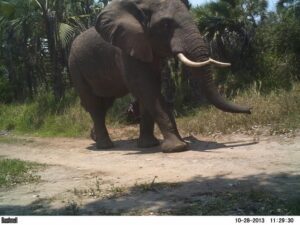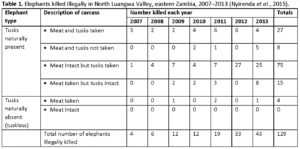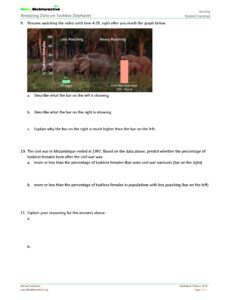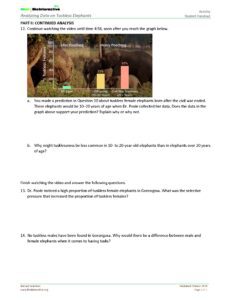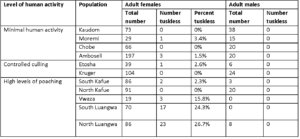Analyzing Data on Tuskless Elephants
BACKGROUND INFORMATION
Both male and female African elephants usually have tusks, long front teeth that grow outside their mouths. Elephants use their tusks to strip bark off trees for food and to dig holes for water and minerals. Male elephants also use their tusks to fight with other males for females. Males without tusks risk being severely wounded and are less likely to be reproductively successful. Do you need help with your assignment ? Contact us at eminencepapers.com.
Cameras in Gorongosa National Park in Mozambique took these images. They show two different African elephants: an elephant with tusks and an elephant without. This absence of tusks, called tusklessness, is a natural but usually rare trait in African elephants.
Scientists are studying how rates of tusklessness in elephant populations — both in Gorongosa and in other regions of Africa — have changed and are continuing to change due to poaching, the illegal hunting and killing of elephants to harvest their tusks for ivory.
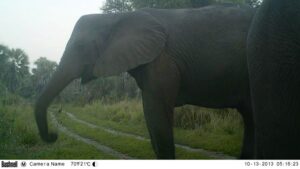
PART I: INTRODUCTION
A survey of African savanna elephants revealed that populations declined by 30% between 2007 and 2014. As of 2014, about 350,000 savanna elephants were living in Africa. Their current rate of decline is 8% per year, primarily due to illegal killing called poaching.
Why are so many elephants being illegally killed? And how is this poaching affecting elephant populations? You will explore these two questions by examining data from several studies and watching a Scientists at Work video about elephants living in Gorongosa National Park in Mozambique.
Pre-Video Activity: Testing Your Prediction
Table 1 shows the number of elephants that were illegally killed in a region of Zambia from 2007 to 2013. The elephants were categorized based on descriptions of their carcasses; these descriptions allow researchers to infer why the elephants were killed.
The first four rows show categories of elephants that originally had tusks. The fifth and sixth rows show categories of elephants that naturally do not have tusks or are tuskless. Individual rows show whether meat and/or tusks were taken from the elephants after they were killed; researchers can infer that these elephants were killed for their meat and/or tusks.
Examine the data and then answer the questions after the table.
Answer the following Questions in BOLD text.
- How did the total number of elephants that were illegally killed change from 2007 to 2013?
Between 2007 and 2013, the number of elephants killed illegally increased for both elephants with tusks naturally and tuskless elephants, as shown by the last row in the table.
- In general, did most of the illegally killed elephants have tusks, or were they naturally tuskless?
Most of the elephants killed had tusks naturally, with most being the ones killed for tusks.
- Calculate the total number of elephants that appear to have been illegally killed between 2007 and 2013 for:
- only their meat = 19
- only their tusks = 75
- both their meat and tusks = 27
- Calculate the percentages of the illegally killed elephants between 2007 and 2013 represented by each group of elephants in Question 3. Show your work.
- percentage of elephants killed only for their meat
= 14.73%
- percentage of elephants killed only for their tusks
= 58.14%
- percentage of elephants killed for both their tusks and meat
= 20.93%
- Use the evidence above to claim the main reason elephants were illegally killed in this region.
Based on the above analysis, the main reason the elephants were killed in the region between 2007 and 2013 was to obtain their tusks. This can be regarded as poaching, where the poachers kill the elephants to obtain tusks for sale at high prices due to high demand.
- Suggest ways to reduce the number of elephants illegally killed each year.
One of the ways to reduce the number of elephants being killed in the region is by enacting stricter laws and punishments for people who engage in illegal poaching. The government can also create awareness about illegal poaching and why it is important to protect wildlife for the larger benefit of wildlife.
Video Activity
- Watch the Selection for Tuskless Elephants video until time 1:46 and answer the following questions.
- What did Dr. Joyce Poole observe about the elephant population in Gorongosa National Park in Mozambique?
Dr. Joyce Poole reiterates that even 20 years after heavy poaching in Gorongosa National Park, there are many elephant populations with noticeable scars (Selection for Tuskless Elephants).
- What happened in Mozambique from 1977 to 1992?
Between 1997 and 1992, a civil war occurred in Gorongosa, which led to the massive killing of elephants, with over 90% being killed during the period.
- How were the elephants in Gorongosa National Park affected by this event?
After the massive killing of elephants in Gorongosa due to the civil war, the effect at Gorongosa National Park was evident 20 years later since the number of elephants in the park has never recovered.
- Resume watching the video until time 4:03 and answer the following questions:
- Select (circle) all the descriptions that apply to the trait of “tusklessness.” For example, it occurs naturally in elephant populations, does not occur in nature, is common among most elephants, is more prevalent in males than females, is more prevalent in females than males, and is inherited.
Descriptions that apply to the trait of “tusklessness
- It occurs naturally in elephant populations
- Is inherited
Dr. Poole says there is strong selective pressure for male elephants to have tusks. Explain what that means.
In the context of the video, selective pressure for male elephants to have tusks implies that male elephants with tusks are more likely to pass on their genes than those without tusks.
- Resume watching the video until 4:29, right after you reach the graph below.
- Describe what the bar on the left is showing.
The bar on the left shows the percentage of tuskless female elephants (all ages) in an environment with low poaching rates. The percentage (6%) is relatively low, which indicates that the number of tuskless elephants is generally low.
- Describe what the bar on the right is showing.
The bar on the right shows the percentage of elephants who survived the civil war in an environment with heavy poaching. The elephants are 20 years old and older since the civil war occurred 20 years before the data was recorded. The number is high, which indicates that tuskless elephants were not at a high risk of being killed.
- Explain why the bar on the right is much higher than the bar on the left.
The bar on the right is much higher than on the left since more elephants with tusks were killed during the war than elephants without tusks. The tuskless female elephants were not killed in large numbers; perhaps the proportion killed was for meat. Since the total number of elephants decreased, the number of female tuskless elephants formed a high proportion of the elephants.
- The civil war in Mozambique ended in 1992. Based on the data above, predict whether the percentage of tuskless females born after the Civil War was:
- More or less than the percentage of tuskless females that were civil war survivors (bar on the right)
Based on the data and the bar on the right, the percentage of tuskless females born after the civil war was less compared to the survivors of the war. This is because, despite the probable deaths of the 20 years of war survivors over time, the number remained above 50%.
- more or less than the percentage of tuskless females in populations with less poaching (bar on the left)
Based on the data and the bar on the left, the percentage of tuskless females born after the Civil War was higher than the percentage of tuskless females in populations with less poaching.
- Explain your reasoning for the answers above:
- The prediction is justified since the number of tuskless elephants in areas with less poaching indicates that the birth rates of female tuskless elephants are low. Therefore, female tuskless elephants are more likely to comprise the survivors of the civil war compared to the elephants born tuskless.
- Due to the number of tuskless elephants passing their genes to the young, there is a high likelihood that many tuskless elephants will increase going forward.
PART II: CONTINUED ANALYSIS
- Continue watching the video until 4:56, after you reach the graph below.
You predicted Question 10 about tuskless female elephants born after the Civil War ended. When Dr. Poole collected her data, these elephants would be 10–20 years of age. Does the data in the graph above support your prediction? Explain why or why not.
The data in the graph supports my prediction since the percentage of tuskless elephants born is higher than the tuskless elephants in low poaching areas but lower than the percentage of tuskless females who survived the civil war. Eventually, the number of female elephants born tuskless will increase.
- Why might tusklessness be less common in 10- to 20-year-old elephants than in elephants over 20 years of age?
Tusklessness may be less common in 10- to 20-year-old elephants than in elephants over 20 years of age since, although the birth rate of tuskless elephants will lead to an increase, the number of tuskless survivors will remain higher than the newborn elephants. Therefore, tuskless elephants over 20 years will be more common.
Finish watching the video and answer the following questions.
- Dr. Poole noticed a high proportion of tuskless female elephants in Gorongosa. What was the selective pressure that increased the proportion of tuskless females?
The selective pressure that increased the proportion of tuskless females was due to human activity, where poaching led to eliminating tusked elephants, leaving the tuskless elephants to thrive and pass their tuskless alleles; hence, the population continued increasing.
- No tuskless males have been found in Gorongosa. Why would there be a difference between male and female elephants when it comes to having tusks?
There would be a difference between male and female elephants regarding having tusks since males must have tusks to pass their genes. Due to intrasexual relationships, the male elephants have to fight to determine who mates with the females. Thus, males with no tusks are disadvantaged in fighting, which means that a few tuskless will mate with females to continue their generations. Therefore, elephants with tusks are likely to be more.
Table 2. Tusklessness in different African elephant populations (Steenkamp et al., 2007). In populations experiencing controlled culling, humans legally removed a restricted number of elephants to prevent overpopulation. These elephants were usually chosen randomly. In populations experiencing poaching, humans illegally killed an unrestricted number of elephants. These elephants were usually killed for their tusks.
Cite evidence based on the data above or in the Selection for Tuskless Elephants video.
Claim:
In general, the prevalence of female tuskless elephants is highest in areas with heavy poaching.
Evidence:
Table 2 above shows the proportions of tuskless elephants in areas with varying poaching rates, it is evident that, generally, the areas with high poaching rates are characterized by higher percentages of tuskless elephants compared to the areas with controlled culling and minimal human activity.
Reasoning:
The evidence shows a high association between the number of tuskless elephants and the rate of poaching in an area. Particularly, the number of tuskless elephants will be higher in areas with higher poaching rates. This is logical since reducing the number of tuskless elephants with tusks will result in a higher proportion.
Proportions of tuskless elephants in the three regions;
Minimal human activity: (0%+3.4%+0%+1.5%)/4 = 1.225%
Controlled culling: (2.6%+0%)/2 = 1.3%
High levels of poaching: (2.3%+0%+15.8%+24.3%+26.7%)/5 = 13.82%
Work Cited
“Selection for Tuskless Elephants.” HHMI BioInteractive, 23 Sept. 2016, https://www.biointeractive.org/classroom-resources/selection-tuskless-elephants. Accessed 20 Jan. 2023.
ORDER A PLAGIARISM-FREE PAPER HERE
We’ll write everything from scratch
Question

Analyzing Data on Tuskless Elephants
Download Lab#1 Questions to turn in: Lab 1 Analyzing Data on Tuskless Elephants.docx Download Lab 1 Analyzing Data on Tuskless Elephants.docx
Description:
This is a data-driven activity to accompany the video Selection for Tuskless Elephants. It has you analyzing data to make evidence-based claims about the occurrence of trustlessness in elephant populations.
By watching this video, you will follow the analyses and discoveries of Joyce Poole, a scientist who has studied elephants for many years. You will then analyze data to investigate the impact of human poaching on elephant populations.
Question: Some scientists believe tuskless elephants would have a higher longevity than tusked elephants. What factors affect how human activity impacts changes in elephant populations?
Purpose:
- To practice the steps of the Scientific Method
- To determine which environmental variables influence how long elephants live.
- To practice interpreting data charts and graphs by analyzing quantitative data to make predictions based on evidence.
- Use evidence-based predictions to explain how a population changes due to human impacts over time.
- Explain how the selective pressures on a population may impact the frequencies of phenotypes.
- Propose a claim supported by scientific evidence to answer a research question.
- Determine whether scientific results confirm or contradict a hypothesis.
- Provide evidence-based reasoning that uses available data to support a scientific claim.
Key Terms:
adaptation, claim, evidence, frequency, phenotype, poaching, population, reasoning, selection, selective pressure, variation
Procedure: You will watch short videos to obtain the information necessary to answer the lab questions. Use this resource to select video resources for Tuskless Elephants. Links to an external site.
Step 1: Analyzing Data on Tuskless Elephants. Lab #1 Picture n questions.
Step 2: Watch the Video 6:39 min video of Selection for Tuskless Elephant.
Step 3: Answer Lab Questions on the Lab #1 handout (link above and handout in the Module): This data-driven activity accompanies the video Selection for Tuskless Elephants. It engages students in analyzing data to make evidence-based claims about the occurrence of tusklessness in elephant populations.
Step 4: Submit your Lab 1 answers under the Canvas Lab Assignment #1 Note: the due date is in Canvas.

